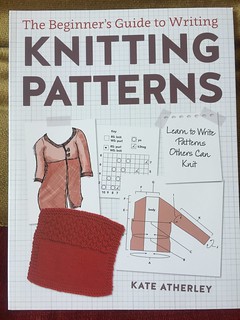
First, the facts:
Title: The Beginner’s Guide to Writing Knitting Patterns: Learn to Write Patterns Others Can Knit
Author: Kate Atherley
Published by: Interweave Press, 2016
Pages: 127
Type: How-to
Chapters:
Introduction
1. Pattern Structure and Elements
2. The Actual Knitting Instructions
3. Charts
4. Grading
5. Formatting & Layout
6. The Process
7. Selling Online
8. On Copyrght
Appendix A: Basic Pattern Template
Appendix B: Abbreviations, Standard Terms and Glossary
Appendix C: Resources & Bibliography
The In-Depth Look:
It’s about time, frankly, that someone put together a book this good, this thorough, and this useful for pattern writing.
You might have noticed that knitting is rather, um, popular these days. Despite the good showing of the recent surge in adult coloring books, I don’t see interest in knitting waning any time soon.
But, like anything else, once people have done something for a while, they start to want to do more. You’ve mastered garter stitch? Try stockinette stitch. You’ve mastered hats? Try mittens. You’ve mastered cables? Try lace.
You’ve mastered following patterns? Try designing your own.
I think this is an excellent idea, mind you. I’m a huge fan of being a Thinking Knitter, and for a lot of basic shapes and styles, there’s really no reason most moderately skilled knitters couldn’t simply design their own pullovers or basic shawls. Why not? It’s fun!
But the next step … sharing your patterns with others? Ah, that’s where new designers get into trouble. They think it’s easy. Yes, some parts might be–knitting a swatch, plotting a curve on a graph, combining colors–but others? How about scaling a pattern for different sizes? What about creating stitch charts? Or writing the instructions so that they’re clear? Just because you can read that specialized knitting code of “(RS) K3, p1, *k tbl, p1, C6R, p1, rep from * 3 times.” doesn’t mean it can’t be improved.
Like anything else, good designing is a lot harder than it looks. Anyone can write a sentence, after all, but not everyone is Shakespeare.
So here, finally, is a book that actually tells you how to write patterns for other people–patterns you can design and then sell. Patterns people will want to knit.
Mind you, this isn’t a book about the process of designing. It’s not going to tell you how to shape a sleeve cap or how to get the best gauge for the perfect drape. It’s about writing the pattern. It says right in the introduction, “This book is for any knitter who creates his or her own designs and is looking to write instructions to allow others to knit those designs.”
Honestly, I can only wonder what took so long. I’ve seen far too many bad patterns out there–and by “bad” I mean badly realized, badly designed, badly written, badly spelled, as well as just plain ugly. Sometimes the fault is the design itself, with things like sleeve cuffs so small you’d never fit a hand through it, but most of the time? It’s not so much the design as the instructions I’m supposed to follow to get that finished product on my needles.
Thank you, Kate Atherley, for putting together this incredibly clear, concise, and useful book for all those talented designers out there who don’t quite know how to get their instructions down on paper for other people. I think your book is brilliant and sorely needed.
Which means, if it wasn’t clear enough, that if you are even remotely interested in producing knitwear designs for other people, and if you’ve never done this before, you really need to get this book. Trust me. I’ve seen far too many otherwise brilliant designs suffocating under terribly written instructions and horrible charts and pattern layout. Don’t let that happen to you!
You can get your copy here or at your favorite local shop.
Want to see bigger pictures? Click here.
This review copy was kindly donated by Interweave Press. Thank you!
My Gush: It’s about time.
Other posts for this author:

 This is only a sampling of the many pictures we took. This house, escuse me ‘summer cottage’ is incredibly beautiful and interesting. To read more about it and the original owners, William Kissam Vanderbilt and his eclectic and interesting wife Alva… CLICK HERE and CLICK HERE
This is only a sampling of the many pictures we took. This house, escuse me ‘summer cottage’ is incredibly beautiful and interesting. To read more about it and the original owners, William Kissam Vanderbilt and his eclectic and interesting wife Alva… CLICK HERE and CLICK HERE













 Ostensibly, I’d signed up for the
Ostensibly, I’d signed up for the  My Craftsy class
My Craftsy class 















